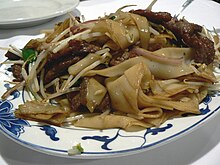
Back Ternera chow fun Spanish Beef chow fun French Chow fun daging sapi JV 곤차우응아우호 Korean Chow fun daging Malay 乾炒牛河 Chinese 乾炒牛河 ZH-YUE
This article needs additional citations for verification. (December 2012) |
 Dry-fried beef hor fun | |
| Alternative names | Wide flat rice noodle |
|---|---|
| Course | Main |
| Place of origin | Guangdong, China |
| Serving temperature | Hot |
| Main ingredients | bean sprouts, soy sauce, rice noodles, onions |
| Beef chow fun | |||||||||||||
|---|---|---|---|---|---|---|---|---|---|---|---|---|---|
| Traditional Chinese | 乾炒牛河 | ||||||||||||
| Simplified Chinese | 干炒牛河 | ||||||||||||
| |||||||||||||
Beef chow fun, also known as beef ho fun, gōn cháau ngàuh hó, or gānchǎo níuhé in Chinese (乾炒牛河) meaning "dry fried beef Shahe noodles", is a staple Cantonese dish, made from stir-frying beef, hor fun (wide rice noodles) and bean sprouts. It is commonly found in yum cha restaurants in Guangdong, Hong Kong, and overseas, as well as in cha chaan tengs. Chow fun, or stir-fried hor fun (shahe fen) noodles, is any number of different individual preparations (and could be compared to the number of pizza varieties in United States cuisine).[1] In the Philippines, it is called "beef hofan" (河粉).
The main ingredient of this dish is hor fun noodles, which is also known as shahe fen, originating in the town of Shahe in Guangzhou. It is a wide, flat noodle that is cut into shape (qiefen).[2] The most common methods of cooking hor fun are in soup or stir fried. Hor fun can be dry-fried (fried only with condiments such as soy sauce) or wet-fried (fried with a thickening sauce). Today, the dry-fried variant is much more common, to the extent that the method is usually not specified—"hor fun" on a restaurant menu would refer to dry-fried hor fun. Further, wet-fried hor fun usually consists of seafood, while dry-fried hor fun usually consists of beef or chicken.
Sliced beef is marinated first. Then, the beef is seared in a wok; this is important to obtain the signature taste of beef chow fun (wok hei). Other ingredients and the hor fun noodles are added, then combined with the beef and sauce. The bean sprouts are then stir-fried with the rest of the chow fun until they are tender and the dish is ready to serve.[3]
An important factor in the making of this dish is wok hei (鑊氣). The cooking must be done over a high flame and the stirring must be done quickly. Not only must the hor fun be stirred quickly, it must not be handled too strongly or it will break into pieces. The amount of oil also needs to be controlled very well; if not, the excess oil or dry texture will ruin the dish.[3] Because of these factors, this dish is a major test for chefs in Cantonese cooking.[citation needed] This wok hei provides an almost charred flavor which is hard to obtain without high heat.
- ^ Tiffany Lam and Virginia Lau (24 July 2009). "Chow fun challenge". CNN Go. Archived from the original on 2012-10-19. Retrieved 11 August 2012.
- ^ Yun Li; et al. (24 March 2016). "Traditional Chinese Rice Noodles: History, Classification, and Processing Methods" (PDF). China Highlights. Retrieved 14 September 2016.
- ^ a b "Beef Chow Fun Noodles (Gon Chow Ngau Ho)". AACC International, Inc. 2015. Retrieved 14 September 2016.
© MMXXIII Rich X Search. We shall prevail. All rights reserved. Rich X Search